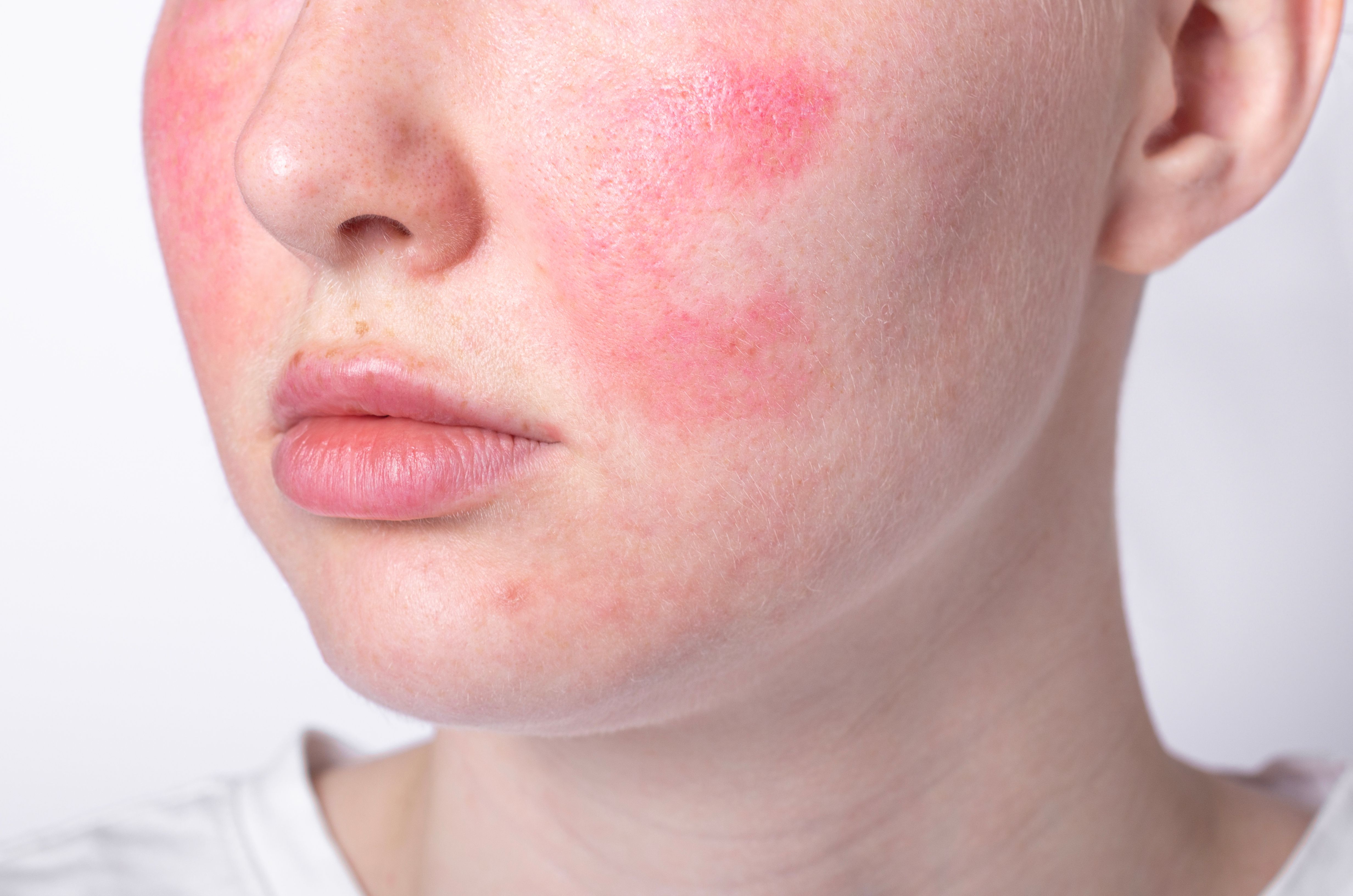- Acne
- Actinic Keratosis
- Aesthetics
- Alopecia
- Atopic Dermatitis
- Buy-and-Bill
- COVID-19
- Case-Based Roundtable
- Chronic Hand Eczema
- Chronic Spontaneous Urticaria
- Drug Watch
- Eczema
- General Dermatology
- Hidradenitis Suppurativa
- Melasma
- NP and PA
- Pediatric Dermatology
- Pigmentary Disorders
- Practice Management
- Precision Medicine and Biologics
- Prurigo Nodularis
- Psoriasis
- Psoriatic Arthritis
- Rare Disease
- Rosacea
- Skin Cancer
- Vitiligo
- Wound Care
News
Article
IPL and BoNT/A Synergy for Rosacea
Author(s):
Key Takeaways
- Combining IPL and BoNT/A may enhance therapeutic outcomes for erythematotelangiectatic rosacea by addressing both inflammatory and vascular components.
- IPL stabilizes mast cell membranes and reduces cytokine release, while BoNT/A inhibits acetylcholine release, reducing vasodilation and inflammation.
Researchers found the combination therapy significantly reduced rosacea severity, with 64% achieving mild or normal status in just 4 weeks.
Rosacea, often characterized by facial redness, visible blood vessels, and inflammatory lesions, is notably challenging to manage with conventional treatments.1 Recent studies suggest that combining Intense Pulsed Light (IPL) and Botulinum neurotoxin Type A (BoNT/A) could yield enhanced therapeutic outcomes compared to monotherapy.2 Most recently, astudy was published evaluating the efficacy of this combined approach in treating erythematotelangiectatic rosacea.3
“To our knowledge, we present the first approach to the use of BoNT/A and IPL in the Latin American population with erythematotelangiectatic rosacea with Fitzpatrick skin type III, opening up a range of therapeutic options that could be useful and available for our patients,” researchers behind the study wrote.
Mechanisms of IPL and BoNT/A in Rosacea Management
Intense Pulsed Light (IPL)
IPL is a light-based therapy commonly used to address various skin conditions, including rosacea. By emitting a broad spectrum of light (500–1200 nm) modifiable through filters, IPL targets erythematous telangiectasia, papules, and pustules. Its therapeutic effects are attributed to mast cell membrane stabilization, reduction in cytokine release, and inhibition of inflammatory mediators such as histamine, MMP-9, and LL-37. Despite its effectiveness, studies stated IPL monotherapy often fails to achieve prolonged results, necessitating complementary treatments for sustained improvement.4
Botulinum Neurotoxin Type A (BoNT/A)
BoNT/A works by inhibiting acetylcholine release, modulating neuropeptides like vascular endothelial growth factor and calcitonin gene-related peptide, and reducing mast cell degranulation. These actions contribute to reduced vasodilation and inflammation, alleviating symptoms such as facial redness. BoNT/A’s effects begin to appear within 3 days post-injection, peaking around 2 weeks. To optimize outcomes, it is recommended to administer BoNT/A either after IPL sessions or with sufficient time between treatments to minimize thermal effects that could impact its efficacy.5
Study Design and Methods
The study evaluated 14 patients (13 women and 1 man, average age 43.7 years) with Fitzpatrick skin type III and erythematotelangiectatic rosacea. Patients were excluded if they had previously undergone topical, injectable, or IPL treatments for rosacea.
Participants received 1 session of IPL at 560 nm with 14 joules, followed by BoNT/A injections at 2.5 U per 0.1 mL. Outcomes were assessed through photographic analysis at baseline and 4 weeks post-treatment. Two dermatologists used the Global Physician Assessment (GPA) scale to evaluate improvement, resolving discrepancies through consensus. A patient satisfaction survey was conducted at the follow-up.
Results
At baseline, rosacea severity was graded on a scale from 0 (normal) to 3 (severe). Of the participants, researchers reported 2 were classified as severe, 6 as moderate, 5 as mild, and 1 as normal. The average GPA score improved from 1.64 (SD 0.84) at baseline to 0.86 (SD 0.66) at follow-up. Notably, no patients remained in the severe category post-treatment, with 12 of 14 patients achieving mild or normal status. The study stated 3 patients reached complete normalization of their condition.
The satisfaction survey revealed that 11 of the 14 participants rated their improvement at 4 out of 5 or higher regarding reductions in erythema and telangiectasia.
Conclusion and Future Directions
This study represents the first documented use of combined IPL and BoNT/A therapy in a Latin American cohort with Fitzpatrick skin type III. Results suggest that this approach offers a promising alternative for managing erythematotelangiectatic rosacea. However, the study's limitations, including a small sample size, lack of a control group, and short follow-up, underscore the need for larger, controlled trials with extended observation periods to validate these findings and assess long-term safety and efficacy.
Researchers found that combining IPL and BoNT/A may provide a synergistic effect, addressing both the inflammatory and vascular components of rosacea, and holds potential as a versatile treatment option for patients struggling with this challenging condition.
References
- Sharma A, Kroumpouzos G, Kassir M, et al. Rosacea management: A comprehensive review. J Cosmet Dermatol. 2022;21(5):1895-1904. doi:10.1111/jocd.14816
- Bloom BS, Payongayong L, Mourin A, Goldberg DJ. Impact of intradermal abobotulinumtoxinA on facial erythema of rosacea. Dermatol Surg. 2015;41 Suppl 1:S9-S16. doi:10.1097/DSS.0000000000000277
- Ardila CG, Colorado Franco LA, Franco M, et al. A case series of a novel approach in the treatment of rosacea: Use of botulinum toxin and intense pulsed light for the treatment of erythematotelangiectatic rosacea. J Cosmet Dermatol. 2025;24(1):e16774. doi:10.1111/jocd.16774
- Jiang P, Liu Y, Zhang J, et al. Mast cell stabilization: new mechanism underlying the therapeutic effect of intense pulsed light on rosacea. Inflamm Res. 2023;72(1):75-88. doi:10.1007/s00011-022-01635-6
- Luque A, Rojas AP, Ortiz-Florez A, Perez-Bernal J. Botulinum toxin: An effective treatment for flushing and persistent erythema in rosacea. J Clin Aesthet Dermatol. 2021;14(3):42-45.
Newsletter
Like what you’re reading? Subscribe to Dermatology Times for weekly updates on therapies, innovations, and real-world practice tips.















